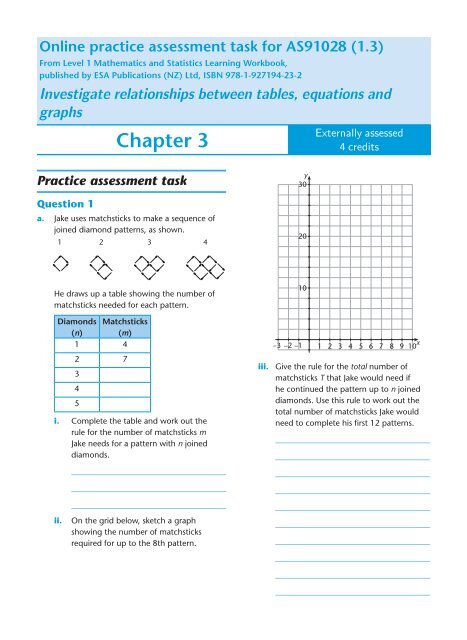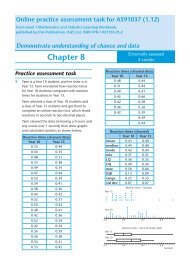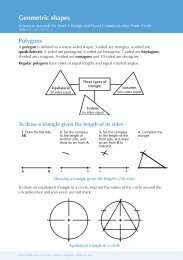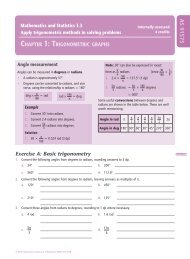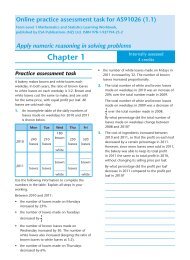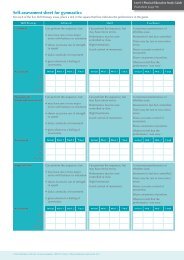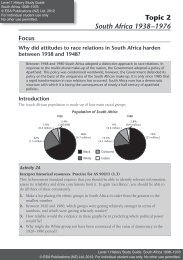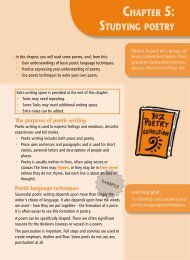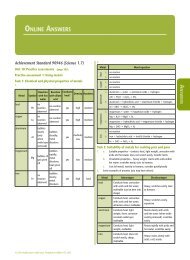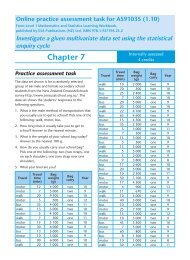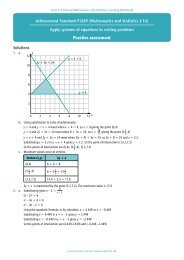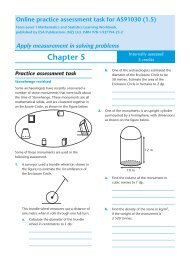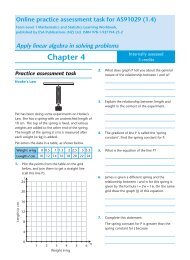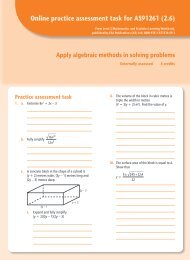Chapter 3 AS91028 online practice assessment ... - ESA Publications
Chapter 3 AS91028 online practice assessment ... - ESA Publications
Chapter 3 AS91028 online practice assessment ... - ESA Publications
You also want an ePaper? Increase the reach of your titles
YUMPU automatically turns print PDFs into web optimized ePapers that Google loves.
Online <strong>practice</strong> <strong>assessment</strong> task for <strong>AS91028</strong> (1.3)<br />
From Level 1 Mathematics and Statistics Learning Workbook,<br />
published by <strong>ESA</strong> <strong>Publications</strong> (NZ) Ltd, ISBN 978-1-927194-23-2<br />
Investigate relationships between tables, equations and<br />
graphs<br />
Practice <strong>assessment</strong> task<br />
Question 1<br />
a. Jake uses matchsticks to make a sequence of<br />
joined diamond patterns, as shown.<br />
1 2 3 4<br />
He draws up a table showing the number of<br />
matchsticks needed for each pattern.<br />
Diamonds Matchsticks<br />
(n) (m)<br />
1 4<br />
2 7<br />
3<br />
4<br />
5<br />
<strong>Chapter</strong> 3<br />
i. Complete the table and work out the<br />
rule for the number of matchsticks m<br />
Jake needs for a pattern with n joined<br />
diamonds.<br />
ii. On the grid below, sketch a graph<br />
showing the number of matchsticks<br />
required for up to the 8th pattern.<br />
y<br />
30<br />
20<br />
10<br />
Externally assessed<br />
4 credits<br />
–3 –2 –1 1 2 3 4 5 6 7 8 9 10<br />
x<br />
iii. Give the rule for the total number of<br />
matchsticks T that Jake would need if<br />
he continued the pattern up to n joined<br />
diamonds. Use this rule to work out the<br />
total number of matchsticks Jake would<br />
need to complete his first 12 patterns.
2 Online <strong>practice</strong> <strong>assessment</strong> task for <strong>AS91028</strong> (1.3)<br />
b. Sam makes a different sequence of diamond<br />
patterns. Sam also starts with 1 diamond, but<br />
he continues his pattern by adding diamonds<br />
as shown below.<br />
i. Give the rule for the number of<br />
matchsticks needed to make the nth<br />
diamond pattern in Sam’s sequence.<br />
ii. Use this rule to find out which of Sam’s<br />
patterns would use 100 matchsticks.<br />
iii. Describe how the graph for the number<br />
of matchsticks Sam uses would relate to<br />
Jake’s graph.<br />
Question 2<br />
2. The Abbot family and the Brown family drive<br />
to the same beach for their holidays. The<br />
Abbot family drives more quickly than the<br />
Brown family. The graph shows the distance<br />
from the beach, d, plotted against time in<br />
hours (t).<br />
200<br />
100<br />
d (kilometres)<br />
1 2 3 4<br />
t (hours)<br />
a. How far do the Browns live from the<br />
beach?<br />
b. At what speed (in kilometres per hour) do<br />
the Abbots drive?<br />
c. How long did it take the Browns to get to<br />
the beach?<br />
d. Write the equation for the Abbots’<br />
distance, d, from the beach at time t.<br />
e. Both families leave home at 10 am. Which<br />
family is closer to the beach by midday?<br />
f. The Chen family drives away from the<br />
beach at 10 am, driving at same speed as<br />
the Abbot family drives. Draw the graph<br />
of the Chen family’s journey on the grid<br />
and work out when the Abbots and the<br />
Chens are both the same distance from<br />
the beach.<br />
Question 3<br />
a. For the parabola drawn below give:<br />
i. the intercepts<br />
ii. the equation of the curve<br />
iii. the coordinates of the vertex<br />
© <strong>ESA</strong> <strong>Publications</strong> (NZ) Ltd, Freephone 0800-372 266
4<br />
3<br />
2<br />
–5 –4 –3 –2 –1 1 2 3 4 5 x<br />
–1<br />
–2<br />
–3<br />
–4<br />
The parabola is reflected in the x-axis then<br />
translated 2 units right.<br />
© <strong>ESA</strong> <strong>Publications</strong> (NZ) Ltd, Freephone 0800-372 266<br />
6<br />
5<br />
1<br />
iv. What is the equation of the parabola<br />
now?<br />
v. What is the y-intercept of the parabola<br />
now?<br />
vi. What is the vertex of the parabola now?<br />
b. Water from a fountain makes a parabolic arch<br />
which can be modelled by the function<br />
h = (x + 1)(5 – x), where h metres is the height<br />
of the water x metres horizontally from the<br />
fountain head.<br />
y<br />
i. Draw the graph of the part of the function<br />
that models the water coming out of the<br />
fountain and hitting the ground.<br />
�n�esti�ate �n�esti�ate relations�ips relations�ips �et�een �et�een ta�les� ta�les� e��ations e��ations an� an� �rap�s �rap�s<br />
10<br />
5<br />
y<br />
–2 –1 1 2 3 4 5 6 7 8 9 10<br />
x<br />
ii. What is the maximum height the water<br />
from the fountain reaches?<br />
c. Bobbits live in villages with doors in the shape<br />
of parabolas, as shown. Bobo the bobbit has<br />
a door which is 1.6 m wide and 2.4 m high.<br />
A 1-m-wide support brace AB is attached<br />
horizontally part-way up the door. Find the<br />
distance AB is below the top of the door.<br />
A<br />
1 m<br />
1.6 m<br />
B<br />
2.4 m<br />
3
4 Online <strong>practice</strong> <strong>assessment</strong> task for <strong>AS91028</strong> (1.3)<br />
Answers<br />
Question 1 (page 129)<br />
a. Diamonds Matchsticks<br />
(n) (m)<br />
1 4<br />
2 7<br />
3 10<br />
4 13<br />
5 16<br />
i. m = 3n + 1<br />
ii.<br />
y<br />
30<br />
20<br />
10<br />
–3 –2 –1 1 2 3 4 5 6 7 8 9 10<br />
x<br />
iii. T = 1.5n 2 + 2.5n<br />
b. i. m = 4n<br />
ii. 25th pattern<br />
iii. Same first point, but line of points is<br />
steeper after that.<br />
Question 2 (page 130)<br />
a. 200 km<br />
b. 80 kilometres per hour<br />
c. 4 hours<br />
d. d = –80t + 240<br />
e. Abbot family<br />
f.<br />
200<br />
100<br />
d (kilometres)<br />
Chen family<br />
1 2 3 4<br />
Same distance at 11.30 am.<br />
Question 3 (page 130)<br />
a. i. (–1,0), (2,0), (0,–2)<br />
b. i.<br />
ii. y = (x + 1)(x – 2)<br />
iii. (0.5,–2.25)<br />
t (hours)<br />
iv. y = –(x – 1)(x – 4) or y = –x 2 + 5x – 4<br />
v. (0,–4)<br />
vi. (2.5,2.25)<br />
10<br />
5<br />
y<br />
–2 –1 1 2 3 4 5 6 7 8 9 10<br />
x<br />
ii. 9 metres<br />
c. 0.9375 m<br />
© <strong>ESA</strong> <strong>Publications</strong> (NZ) Ltd, Freephone 0800-372 266


